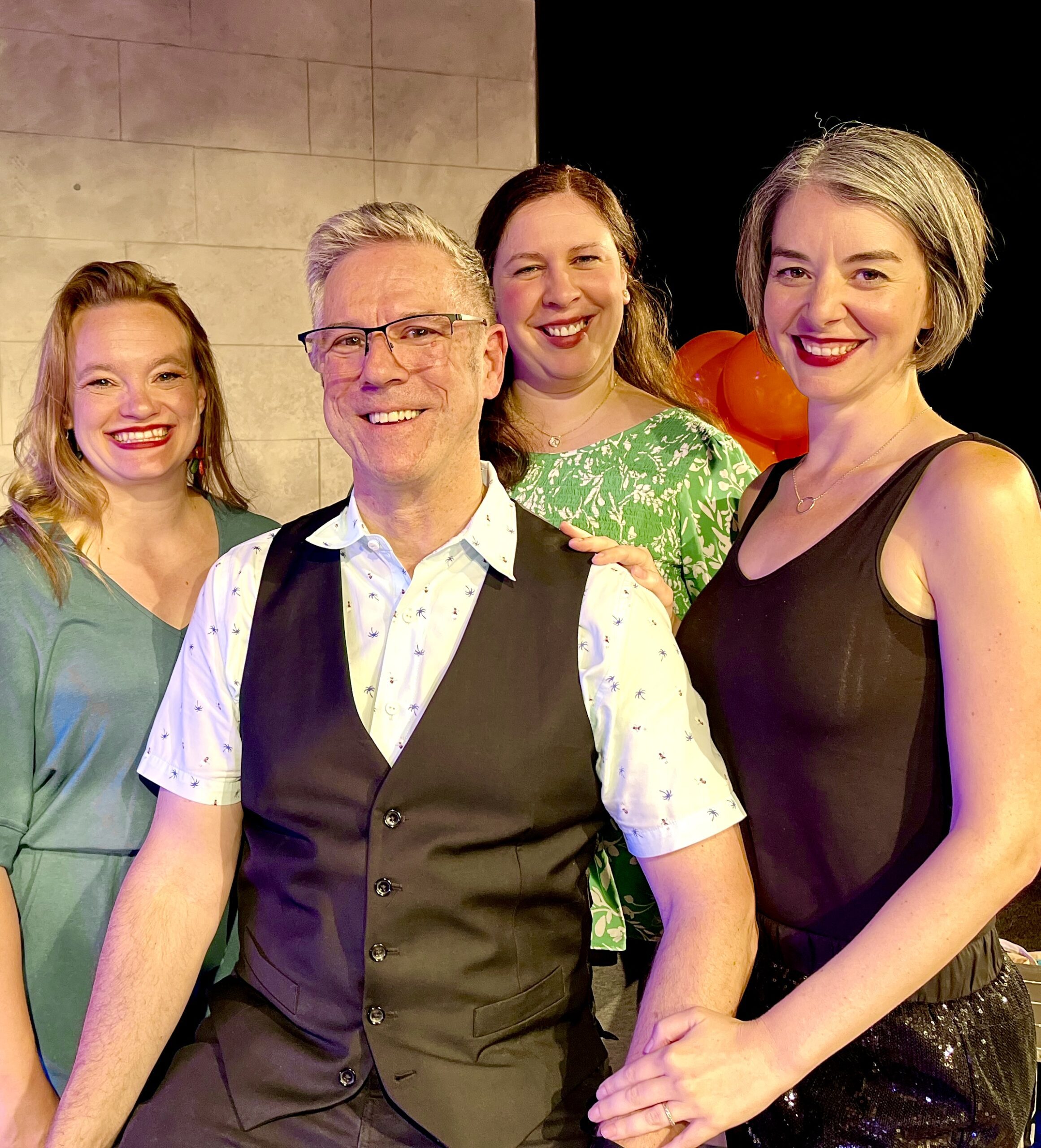West Hartford Residents Advocate to Save Trees Along Boulevard

Audio By Carbonatix
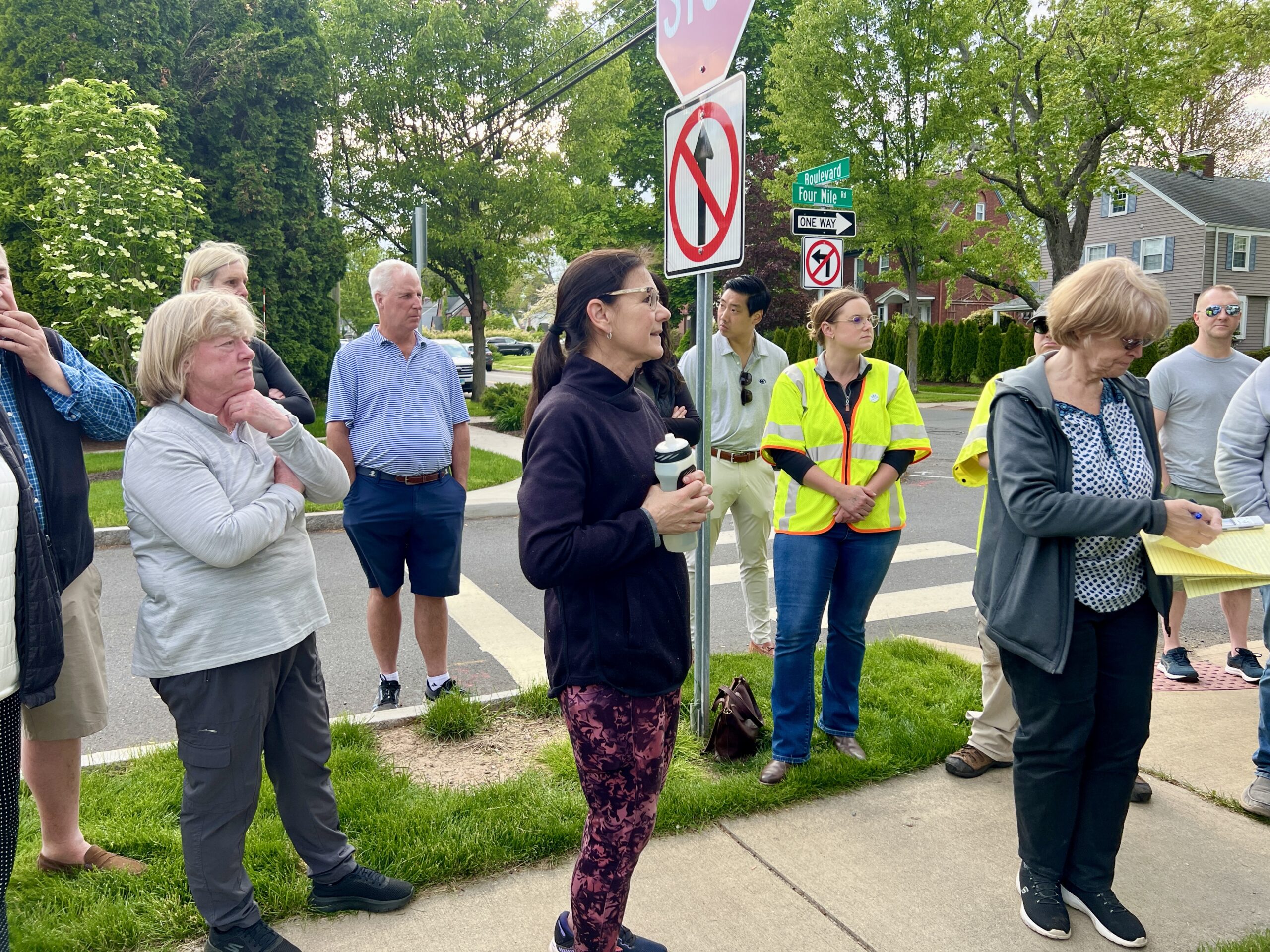
Residents advocate for saving the Bradford Pear trees along Boulevard that have been marked for removal at a public hearing on May 13. Photo credit: Ronni Newton
A well-attended public hearing was held Monday evening on Boulevard, near one of the trees that was posted to be removed by West Hartford’s Tree Warden.
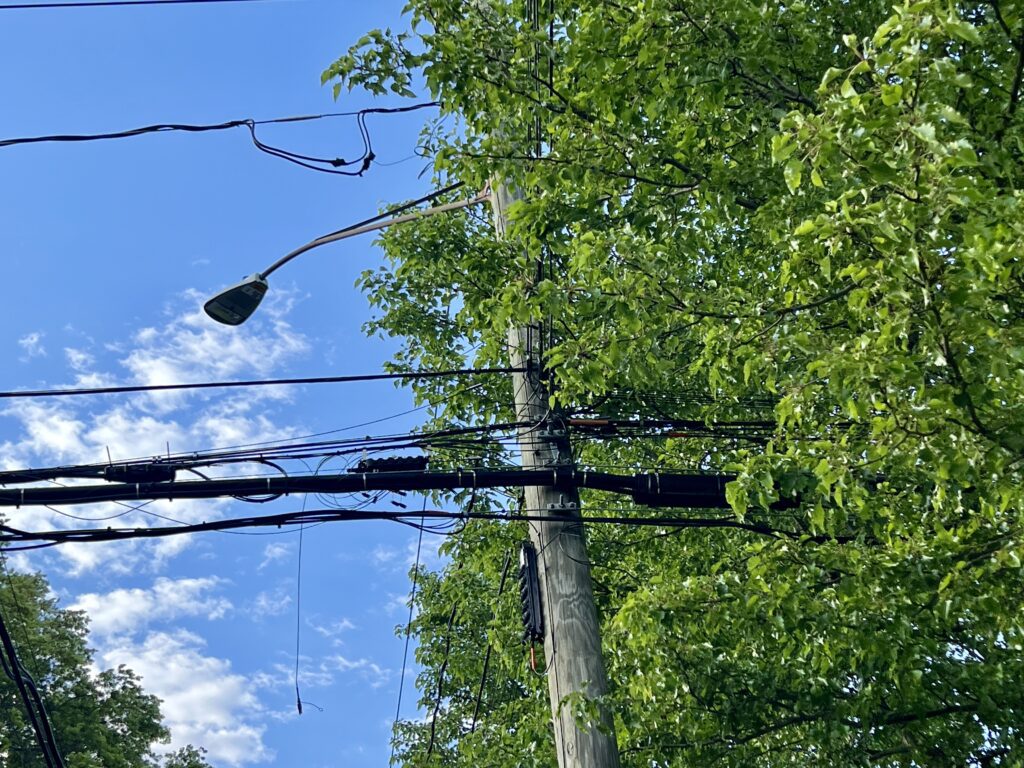
Bradford Pear tree at the southeast corner of Boulevard and Four Mile. Photo credit: Ronni Newton
By Ronni Newton
Roughly 40 people, and a handful of dogs, attended a public hearing early Monday evening on the corner of Boulevard and Four Mile Road in West Hartford, next to one of the trees that has been marked for removal by the tree warden.
John Phillips, West Hartford’s director of Public Works who also serves as the town’s tree warden, convened the hearing in accordance with state statute, and said it’s best to have these types of hearings on site for proper context and to be able to see the tree(s) in question. In this case, Phillips confirmed that 22 Bradford Pear trees on the south side of Boulevard – between Ridgewood Road and South Main Street – have been marked for removal.
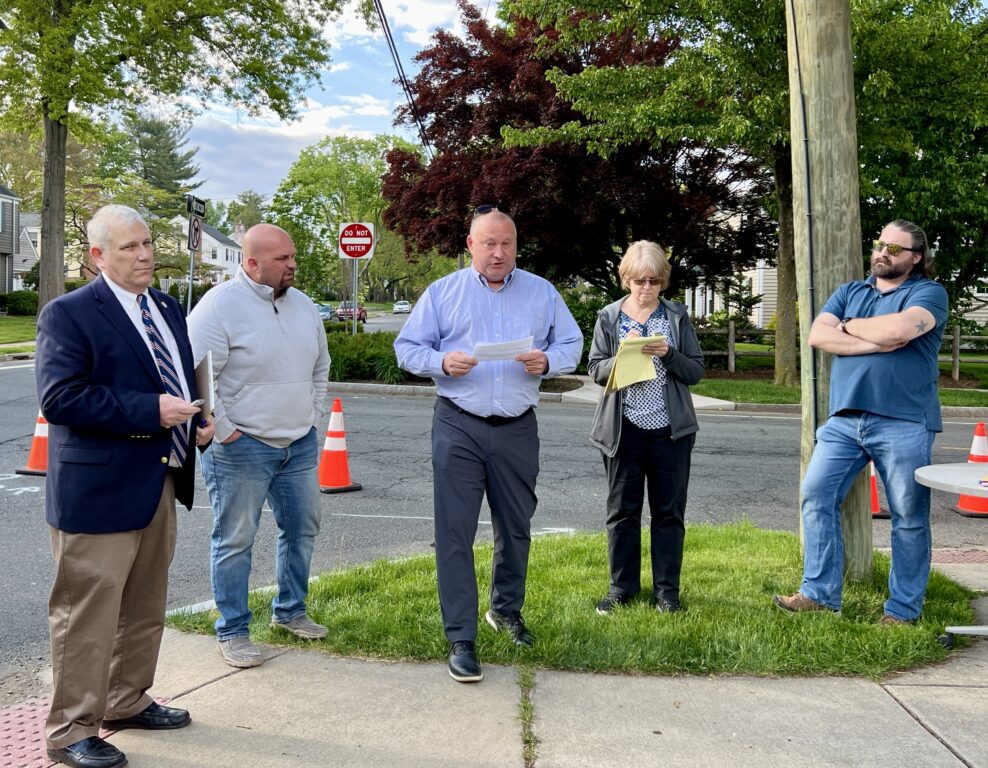
Director of Public Works John Phillips (center), who is West Hartford’s tree warden, held a public hearing Monday about the removal of trees along Boulevard. Photo credit: Ronni Newton
The trees along Boulevard, which is part of the backbone of the town’s electrical grid, were originally being trimmed as part of Eversource’s annual maintenance efforts, and about a half dozen of them had already been trimmed this spring. When he saw how the trees looked, and knew they were right below the wires, Phillips said he had a conversation with Eversource and asked about removing the trees because regular trimming on their schedule wasn’t enough to keep the trees from quickly growing back into the utility wires.
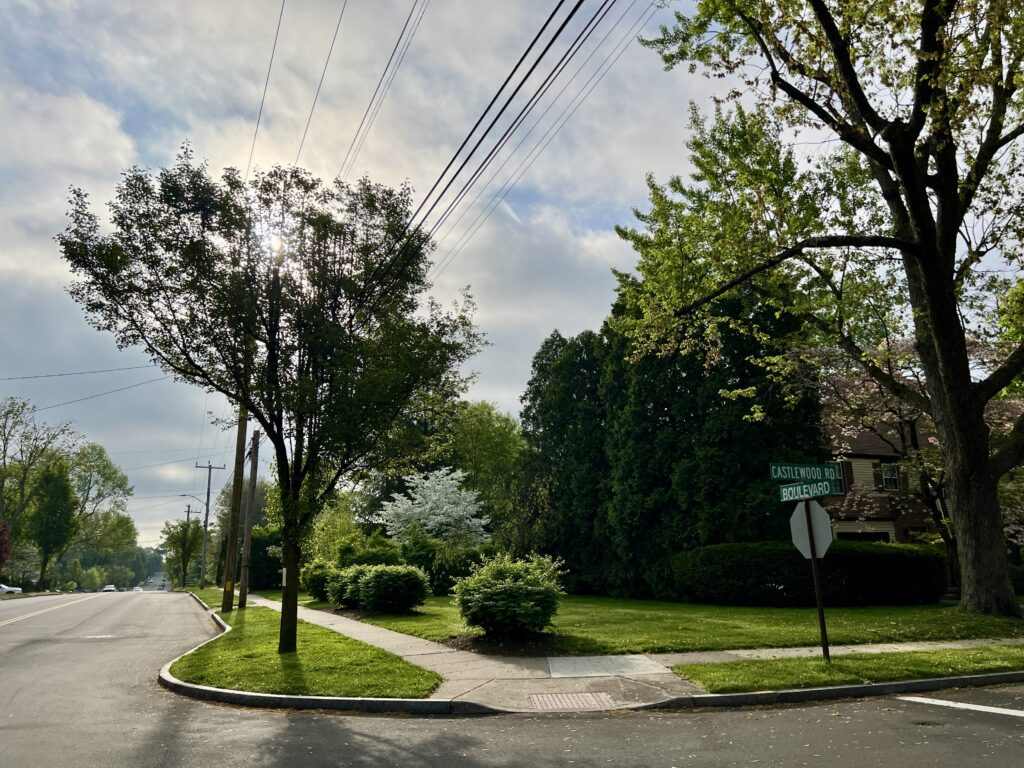
Eversource has already the Bradford Pear trees along the portion of Boulevard closer to Ridgewood Road. Photo credit: Ronni Newton
Phillips said he took a look at the Bradford Pear trees in question and at a May 2 meeting of the Town Council’s Public Works, Facilities, and Sustainability he said it seemed obvious that trimming was “not the right decision,” and no arborist would recommend trimming in a way that chops off the upper part of the tree canopy. Phillips said he asked Eversource to “press pause,” and began the legal process of marking the trees for removal in accordance with state statute for removal of trees in a public right of way or on other public property. That process includes posting a sign on the trees to be removed, and after 10 days, if there are protests, scheduling a public hearing. Following the hearing, he has three days to grant the request for removal or make a decision otherwise.
During his 10 years in the role of tree warden, Phillips said there have only been a handful of times he has had to hold a public hearing about tree removal.

Bradford Pear trees marked for removal along Boulevard. Photo credit: Ronni Newton
There were many residents who emailed or sent letters via mail to Phillips, protesting the removal of the trees, and at least a dozen of those present at the hearing shared their thoughts.
Phillips acknowledged that the trees along Boulevard are “gorgeous in the month of April” with a canopy of white flowers. “They do create a boulevard – pun intended – look to the street,” he said during the Town Council committee meeting.
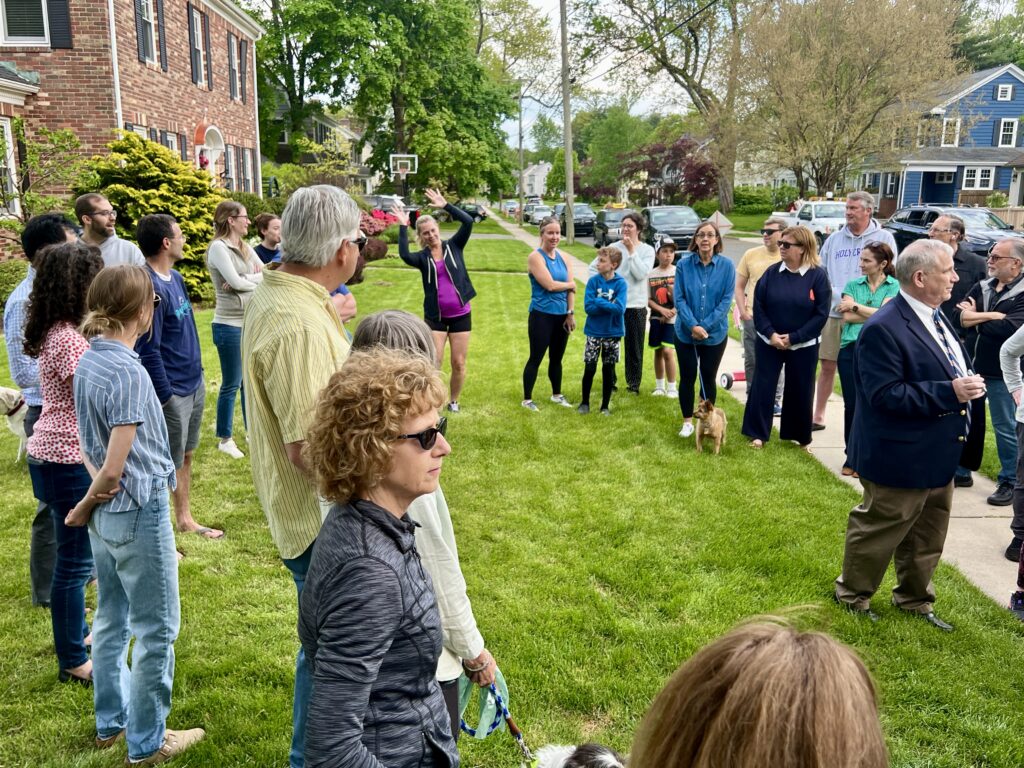
The purpose of Monday’s hearing, he told attendees, was not for a question and answer session, but rather to hear opinions of both sides.
West Hartford Public Works Grounds Manager Justin Andrews said at Monday’s public hearing that his staff is responsible for all of the trees on public property in town. These particular Bradford Pear trees were planted in 2005, he said. “Public Works is about the right tree in the right place. That’s our mission, that’s our goal,” he said, and that wasn’t considered in 2005 in the way it is now. Andrews said he has personally pruned these trees to improve the line of sight, and there have been discussions with Eversource over the years as well to ensure the trees are safe for their infrastructure.
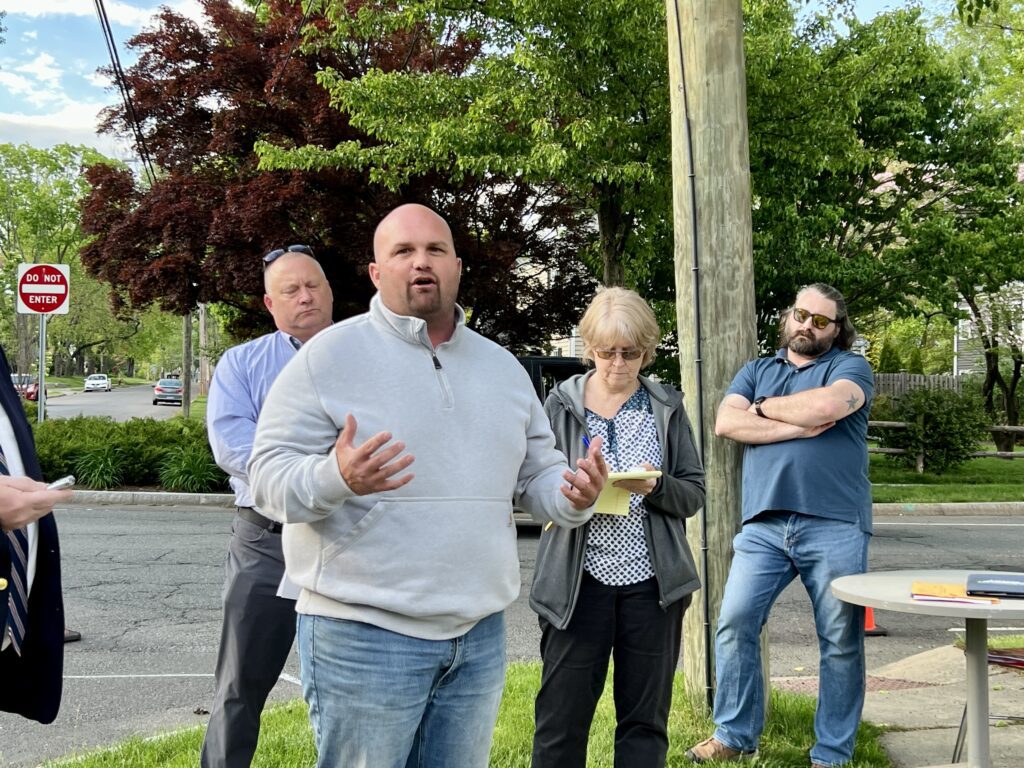
Public Works Grounds Manager Justin Andrews speaks at the public hearing on May 13. Photo credit: Ronni Newton
“For six to eight years we’ve talked about posting these trees for removal,” Andrews said.
Representatives from Eversource also attended Monday’s hearing, including Manager of Vegetation Management for Connecticut Jenna Turner. She educated attendees about Eversource’s infrastructure, noting that the three wires at the top of the poles are the primary lines – carrying between 13,000 and 23,000 volts. The secondary line – the braided one – is the lower voltage that brings power to homes and businesses. The thicker lines are the communications lines, which Eversource does not maintain.
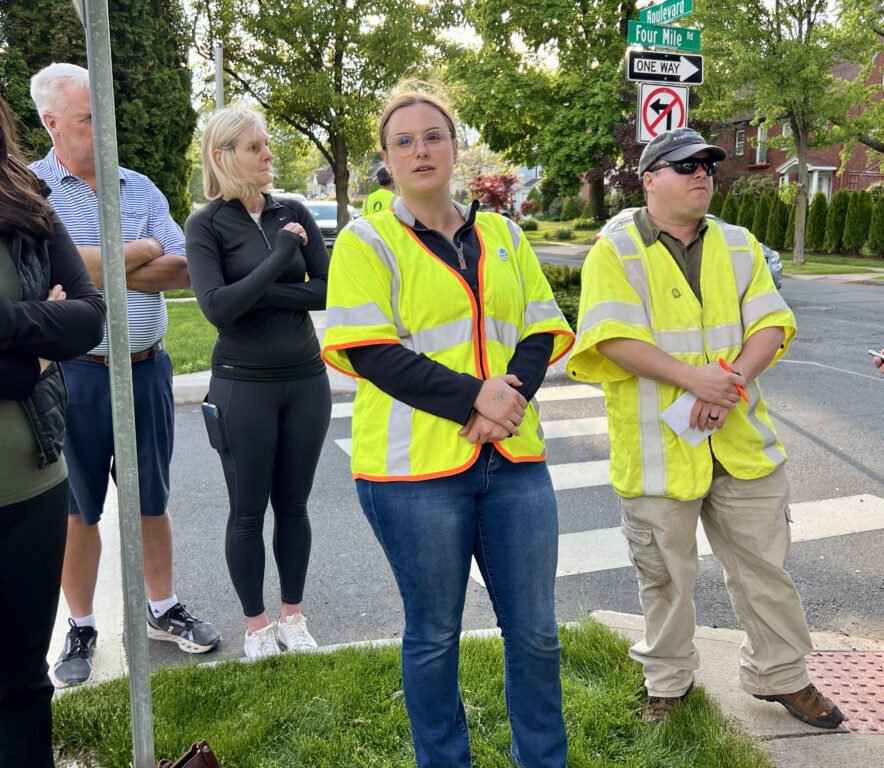
Residents advocate for saving the Bradford Pear trees along Boulevard that have been marked for removal at a public hearing on May 13. Officials from Eversource (in green vests) and Public Works were also on hand. Photo credit: Ronni Newton
The top three lines and the braided, twisted middle line are what need to be kept clear. “Some people think that the thick black covering on the wires is insulation. It’s not. She said there is power running through the wires that can run into the trees.
“Trees contacting the wire can become energized themselves, especially on a rainy day, and trees do catch on fire,” Turner said, just through contact with the wire. “Right here is something we cannot leave in the current state,” she said, pointing at the Bradford Pear on the southeast corner of Boulevard and Four Mile that has branches surrounding growing up, around, and through all of the wires, including the primary wires that carry the highest voltage. “Because the tree is touching the live power lines … at the very minimum we have to prune these trees, all of them that are in direct contact.”
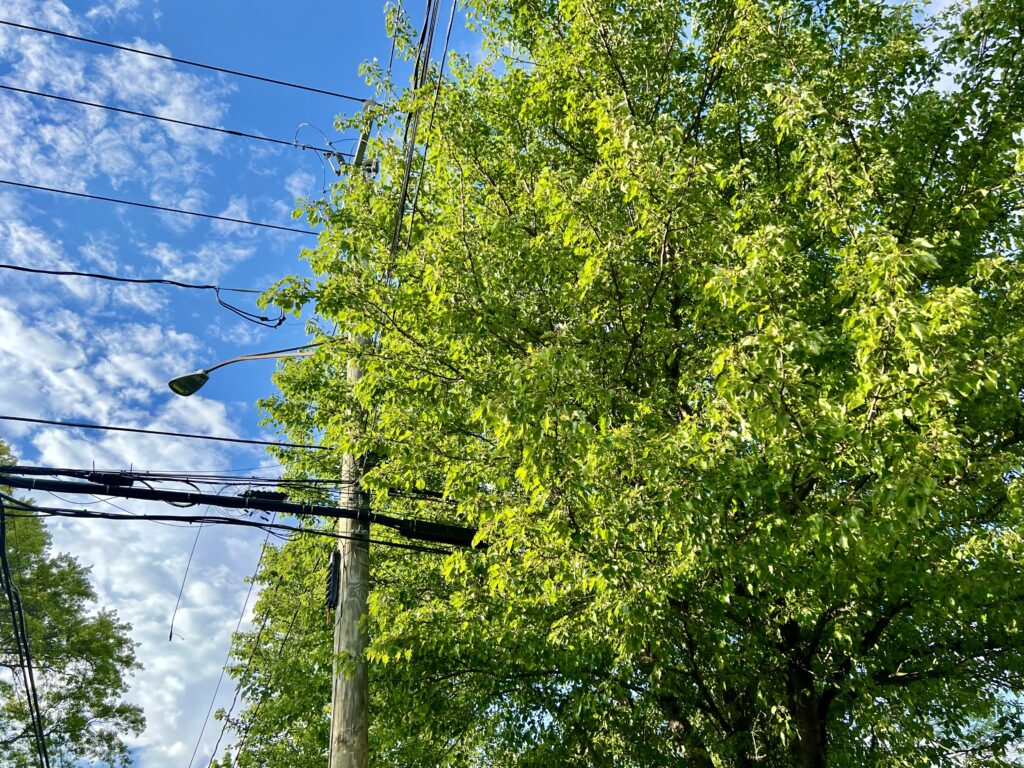
Bradford Pear tree at the southeast corner of Boulevard and Four Mile. Photo credit: Ronni Newton
State law gives Eversource the right to trim trees that are in contact with their wires, Turner said. “What we would really like to do for a long-term sustainable benefit … is to remove the trees because they’re the wrong trees growing in the wrong place. They’re going to continue to grow directly into the power lines year after year.” She said removal is what they would prefer, but the two choices are removing the trees or pruning them so there would be no direct contact with the power lines – adding that because the trees are planted directly below the power lines, “the way they are going to look after they’re pruned is going to be drastic.”
Julian Picciano, Eversource’s arborist for the Hartford district, outlined what the pruning would look like, and also said that the Bradford Pear trees are the “number one in invasive species. It is also a fast-growing and poor-structured species” that commonly fail during storms due to weak branch angles.

Bradford Pear tree at the southeast corner of Boulevard and Four Mile. Photo credit: Ronni Newton
He said these particular trees were last trimmed in 2019, well below the triplex line, and they are already growing back into the power lines. “We still aren’t getting the clearances that we need to last through our cycling,” he said, which is every four to five years.
All who spoke at the hearing live near Boulevard, and no one raised their hand when asked by one of the resident if they were in favor of having the trees removed.
Four Mile Road resident Marija Trcka asked what the plan would be for re-landscaping the area if the trees were removed. “What about the plan post-removal?” she asked. Phillips said it would need to be reviewed by the town’s Engineering Division, and they would need to look at the right-of-way, which has bump-outs installed several years ago for traffic calming, “and determine what is best to plant there both in respect to ‘right tree right place.’ We also have an obligation to look at our Vision Zero safe streets policies.” Because this issue just arose recently, it had not been on the radar for the town’s engineers to consider previously.
“It’s to be determined. That’s the best answer I can give you,” said Phillips regarding future plans to replace any removed trees.
“Our world is getting hotter, and I think we need more trees, not less,” said Pete Carpenter, who also lives on Four Mile. He said he thinks the benefit of having trees in this location, “and not more junipers, is good for the town. We love West Hartford. We love this community because it’s aesthetically beautiful, it’s shaded, it’s a stunning place to live and a lot of that has to do with the greenery of its streets.” He said the idea of taking down 22 trees because of a five-year trimming process “seems kind of short-sighted,” particularly without the guarantee of of adequate replacement. “There’s a shade element, there’s a heat element,” he said.
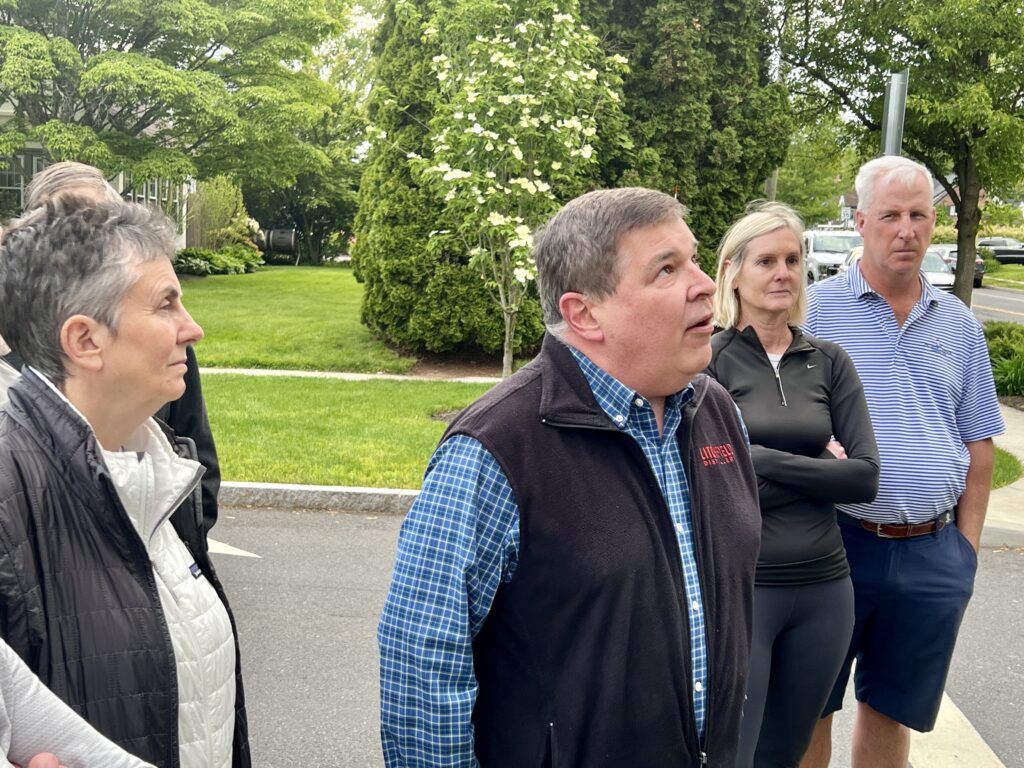
Residents advocate for saving the Bradford Pear trees along Boulevard that have been marked for removal at a public hearing on May 13. Photo credit: Ronni Newton
“This is not just about aesthetics. We’re in a climate crisis,” said Castlewood Road resident Kelly Kennedy, outlining the benefits trees provide in reduction of carbon, prevention of erosion, improving water quality, and providing habitat to nesting birds. She said while she has mixed feelings because these trees are an invasive species, “there should be an environmental impact calculus done.”
Kennedy said Sustainable West Hartford should be made aware of the situation.
Another resident asked if trimming could be done with increased frequency, but Turner responded that they have more than 16,000 miles of distribution lines to trim and can’t come back more often. It took less than five years for the trees on Boulevard to once again be in contact with the power lines, she said. Turner said Eversource specifications are that the trees are trimmed to 10 feet below the primary line, and to remove all contact with the secondary line with at least a two-foot clearance. In response to a question from a resident, she said there are not state regulations regarding the amount of clearance, but Eversource does have the legal right to trim to their specifications.
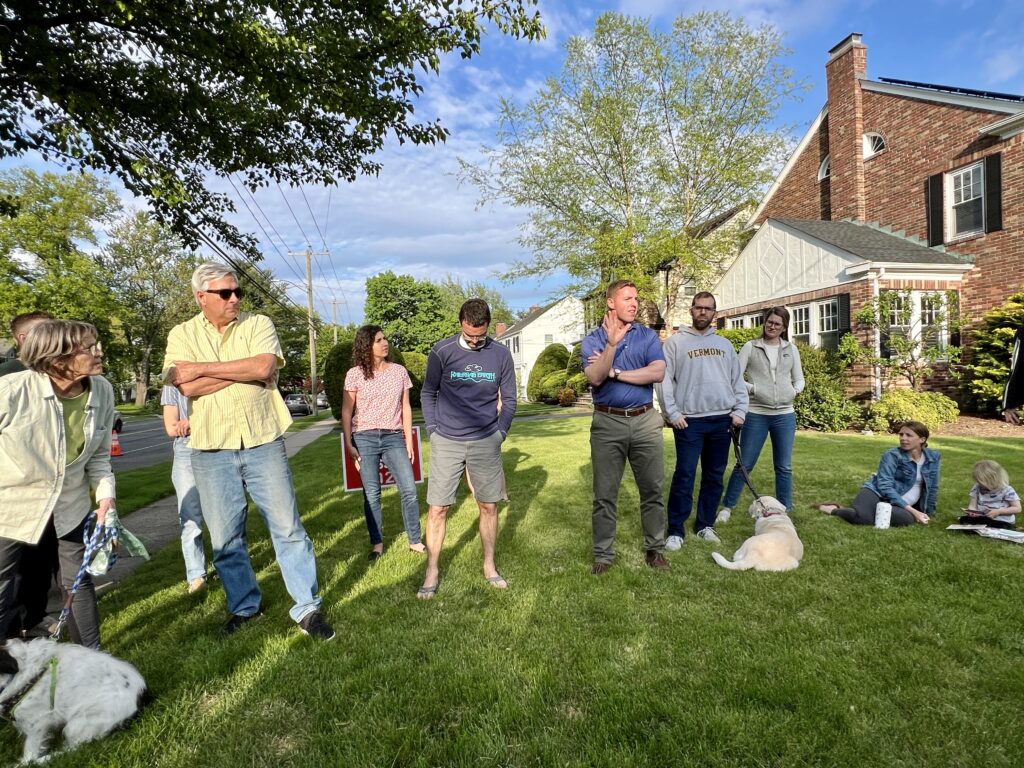
Residents advocate for saving the Bradford Pear trees along Boulevard that have been marked for removal at a public hearing on May 13. Photo credit: Ronni Newton
Other residents said that with the amount of taxes paid in West Hartford, removal of trees will negatively affect home values. One resident said there haven’t been any power outages cause by these trees, and trimming them every five years seems to be working just fine. Maybe trimming them a little more would be fine, too.
While the trees may be invasive, they can still be a positive for the environment, the resident said. “I think it’s a little ridiculous to just to kind of take them all down just because it would be easier for a private company, to which the citizens who already pay a high tax rate are also paying higher and higher each year delivery costs, and we see nothing out of it but the same service.”
Resident Stephen Mann said Eversource is “greedy,” and clearly trimming is an option. “This is how we feel. We want the trees to stay.”
Another resident asked if it would be possible to lower the power lines and allow the tree canopy to grow above them, but Turner said that lowering the lines would pose a public safety hazard, and as lines are replaced they’re being raised. Another resident asked about placing the power lines underground.
“Twenty-two habitats are going to be destroyed,” said Four Mile Road resident Richard Witt.
Four Mile Road resident Katie Robinson said the existing trees do not interfere with line of vision, and it would be devastating to begin taking down all of the invasive species of trees in the town just for that reason. “I think there are options that are lesser than removing the trees,” and she suggested one more time of trimming, which has been effective, “at least until there is an agreeable alternative.”
Four Mile Road resident Jim Schultz questioned why Eversource has said they won’t deal with a limb in front of his house that is hanging over the power line – but not currently touching it – but wants to remove these trees preventatively. Turner said these trees are in contact with the lines.
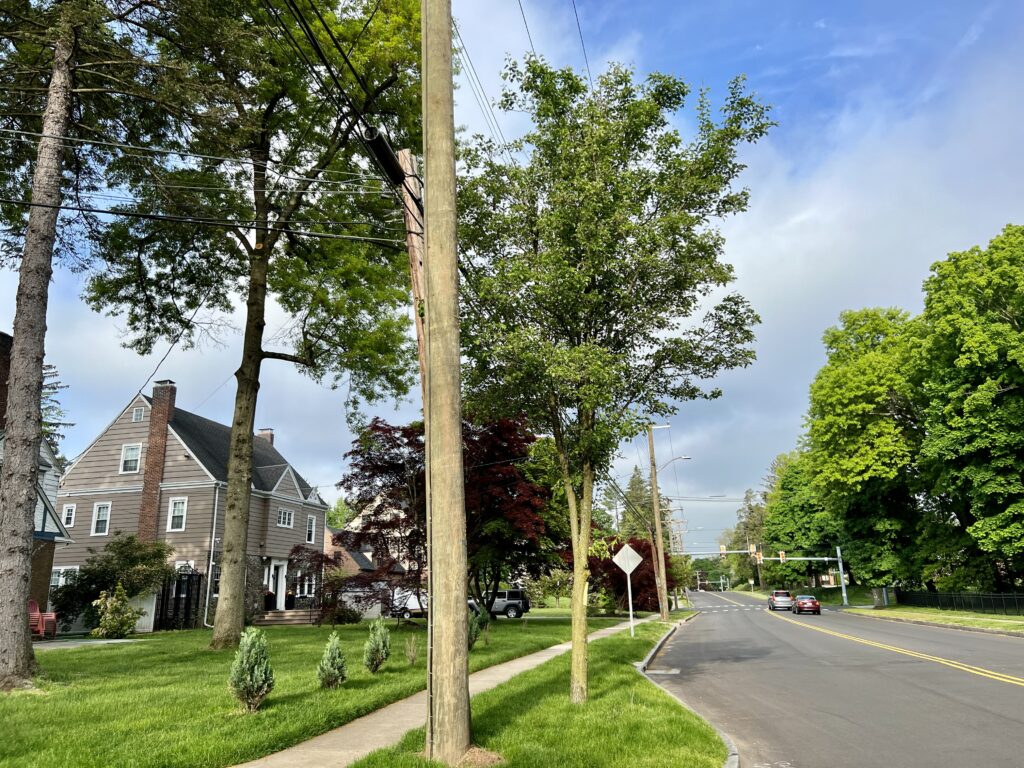
Eversource has already the Bradford Pear trees along the portion of Boulevard closer to Ridgewood Road. Photo credit: Ronni Newton
She urged the residents to take a look at the trees that have already been trimmed. Pear trees can’t be pruned directionally, she said, and the entire top of the canopy needs to be removed.
“I’m well aware of the sensitivity of doing this,” said Phillips. “Even before posting this, I knew it would generate a hearing.” He said there’s not much left of the trees that have already been pruned and he and the grounds manager said it was important to speak to the public about the “right decision vs. an emotional decision.”
“Let’s just prune them down … We have had 20 years. This gives us five more years for the town to figure it out,” said resident Steve Rotundo, a comment that generated applause.
Phillips said the statute requires a decision within three days, and he will render a decision by the end of the day Thursday that will be submitted to the Town Clerk’s office. Those who have emailed him will receive an email announcing that decision.
Like what you see here? Click here to subscribe to We-Ha’s newsletter so you’ll always be in the know about what’s happening in West Hartford! Click the blue button below to become a supporter of We-Ha.com and our efforts to continue producing quality journalism.



